The launch of Mackenzie County’s Lead Testing Program is in response to the updated guidelines put forth by the federal government. Below is a list of common questions and answers about lead and lead testing. Mackenzie County staff are also available to assist ratepayers who are concerned about their water quality or who require information about testing their homes for lead. For more information contact the Utilities Department at 780-928-3983 or by emailing utilities@mackenziecounty.com.
FAQs
Lead is a bluish-grey soft metal that is found in small amounts on the earth’s outer layer. Since lead is highly resistant to corrosion and very malleable, it is used in the construction of piping to transport corrosive liquids, in building construction, lead-acid batteries, bullets, and shot weights. It is part of solder, pewter, fusible alloys, and radiation shields.
Lead is present almost everywhere in nature. It can be found in air, soil, dust, drinking water, food, and other consumer products. Lead can be taken in by the body through ingestion and/or inhalation.
In March 2019, a new lead limit was accepted under the Guidelines for Canadian Drinking Water Quality. This new standard lowers the Maximum Acceptable Concentration (MAC) from 0.010 mg/L to 0.005 mg/L.
Lead enters drinking water by coming into contact with a lead source. If standing water (ex. overnight water in pipes) is in contact with lead materials for several hours, the water may accumulate lead levels that may become a concern. The most common sources are:
- Lead-based solder is used to join copper pipe, faucets made of brass and chrome-plated brass, and in some cases, pipes made of lead that connect a home to the water main (service lines).
- Lead paint and the contaminated dust and soil it generates are the leading sources of lead exposure in older housing.
- Lead has historically been used as a component of paint, piping, solder, brass, and as a gasoline additive.
Many homes constructed before the early 1960s have lead water service lines. Both lead and copper piping were used up until this time when copper water service lines became the standard in the plumbing industry. Most residential lead services are 5/8” diameter. If your home has been renovated, the water service line may have been replaced with a 3/4” water service, which would provide more consistent water pressure and higher flow rates.
Lead-based solder can be another source of lead in drinking water. This type of solder was used for plumbing until the mid-to-late eighties.
Many homes built before the early 1960s used 5/8” diameter lead piping in their construction.
Here are the steps to check if your home has lead piping:
- Locate the water meter (usually found in the basement)
- Look at the pipe coming up through the basement floor into the bottom of the water meter
- Lead
- is grey;
- does not echo if you gently strike it;
- scratches easily;
- leaves metallic marks when you rub the scratched area against a piece of paper.
Note: Service line piping can also be made of polyethylene (black) or polybutylene (black or blue).
The Municipal Government Act makes you, the residential property owner, responsible for the water service connection on your property as well as the plumbing in your home. Typically, lead service connections are found in older homes built before the early 1960s. The Municipality is responsible for the service connection pipes between the property line and the water main in the street.
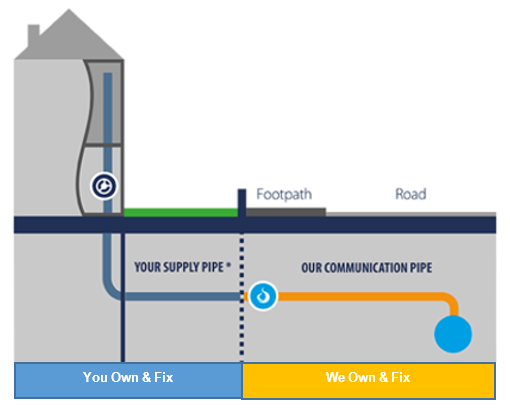
If your home was constructed pre-1960, building codes allowed the use of lead piping for home water services, as well as plumbing solder and brass fittings with high lead content. Lead-based solder can be another source of lead in drinking water. This type of solder was used for plumbing until the mid-to-late eighties. These are the primary sources of lead contamination in drinking water.
Mackenzie County staff will be conducting lead testing through the month of September 2021. To accomplish this, they will be selecting residences that have a higher chance of having lead service lines for their water-based on construction dates and other data.
If you have not been contacted by Mackenzie County County, but wish to have your water tested, please contact Mackenzie County at 780-928-3983 and speak with Sarah Martens, Public Works Administrative Officer (Utility Clerk).
The County will provide water quality testing for identified properties that may have lead water service lines or plumbing and fixtures. Monitoring for lead will require water sampling at the tap within buildings, as lead concentrations can be affected by plumbing fixtures and building service lines, especially in older homes.
Through water sampling, the laboratory will determine if the 0.005 milligrams/liter (mg/L) Maximum Acceptable Concentration (MAC) has been exceeded. If this MAC is exceeded a second sample of the complete line capacity will be done by County to determine where the lead is located.
Through water sampling, the laboratory will determine if the 0.005 milligrams/liter (mg/L) Maximum Acceptable Concentration (MAC) has exceeded. If this MAC is exceeded a second sample of the complete line capacity will be done by County to determine where the lead is located.
Through water sampling, the laboratory will determine if the 0.005 milligrams/liter (mg/L) Maximum Acceptable Concentration (MAC) has exceeded. If this MAC is exceeded a second sample of the complete line capacity will be done by County to determine where the lead is located.
Step 1: Find your emergency water shut-off valve
Once you find your emergency water shut-off valve or water meter in your home (usually in the basement), check the color and hardness of the pipe.
Step 2: Check the pipe color
Check the color of the pipe coming out of the ground and into the meter. You may have to lightly sand the surface of the pipe. If the pipe is:
- The color of a Canadian penny: It’s copper.
- Bright blue or black: It’s likely plastic tubing (polyethylene). Important: Don’t attempt to test the hardness of your pipe if you suspect it’s plastic.
- Grey: It’s galvanized iron or lead.
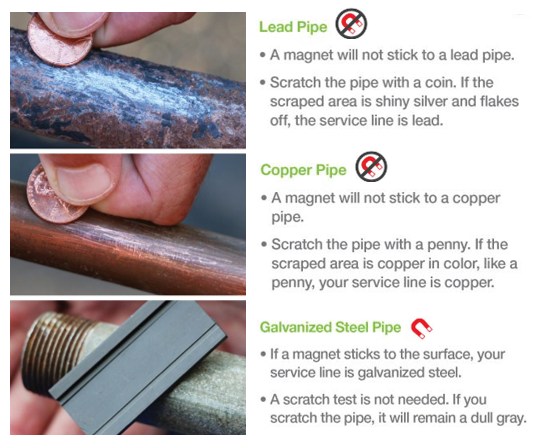
Step 3: Check the pipe hardness
If you think your water service line could be lead, try gently etching into the pipe (see video). Lead is a relatively soft metal and scratches easily. Do not attempt this if you think the line could be plastic.
While this checklist is a good indicator of whether your pipes are lead, please note that every pipe is a little different. The only way to be sure if you have lead is to have your water tested. If you believe you have a lead service line, contact Sarah Martens, Public Works Administrative Officer (Utility Clerk) at 780-928-3983.
If you are concerned about lead in your drinking water, take the following preventive steps to limit possible exposure further:
- Flush standing water in pipes each morning by first flushing the toilet, washing your hands, or letting the water run for five minutes or until it is cold to the touch. Flushing clears water from the plumbing and home service line to ensure the drinking water comes from the main service line.
- Use cold water for drinking and cooking. Hot water dissolves more lead from plumbing. Boiling water DOES NOT remove lead.
- Some home water treatment devices remove lead, but not all do. Before buying, check the various models and their specifications.
You cannot see, smell or taste lead in water. Laboratory testing at the tap is the only way to determine the lead levels in your home. Testing is recommended during warm water periods of May through September.
Residents can also arrange for testing by an accredited and licensed private laboratory. Labs such as:
- Caro Analytical Services (1-780-489-9100)
- ALS Environmental (1-780-539-5196)
- Kaizen Lab Inc (1-888-525-5902)
These labs will be happy to provide you with a cost estimate for a sampling kit and information to sample your home.
Yes, all lead sampling results will be returned to the resident within 14 days of samples being received at the lab. The individual results of testing will only be released to you, the homeowner.
Mackenzie County staff will complete sampling in the Hamlets of Fort Vermilion, La Crete, and Zama as per Alberta Environment’s protocol.
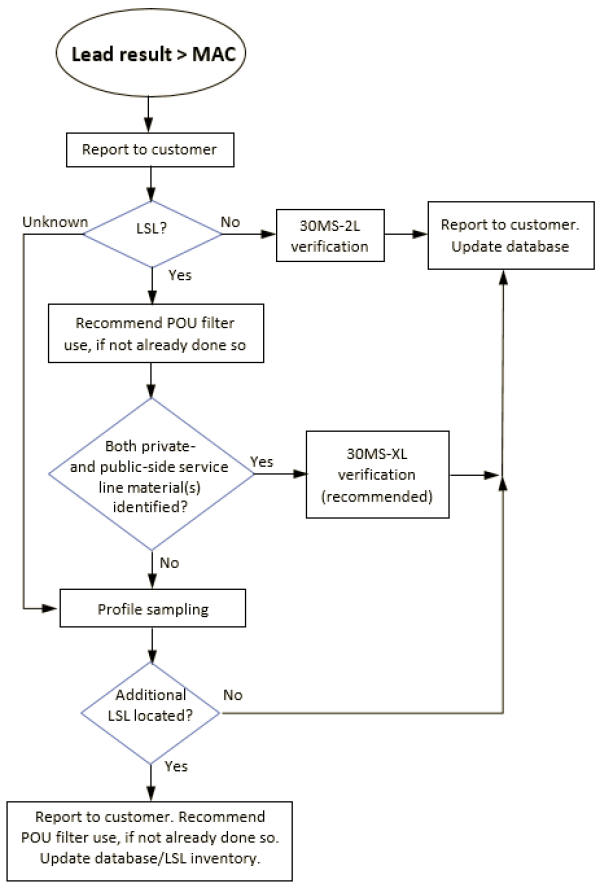
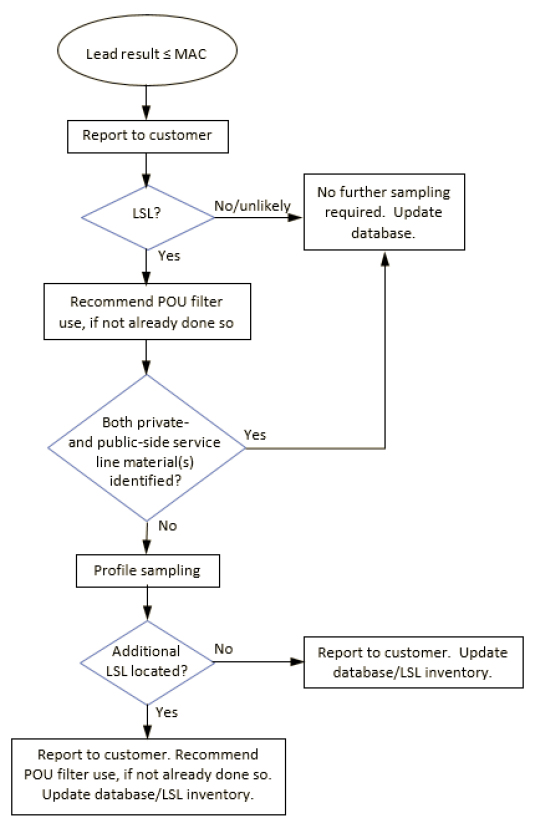
Homes, where lead is greater than (>) 0.005 mg/L, will result in re-testing water as per Alberta Environments “profile sampling” (below). This type of in-depth sampling will be performed to determine the location of the lead source(s).
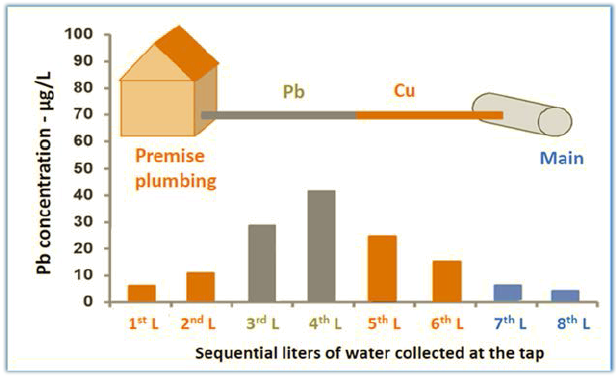
If lead is found on the private property side of the service connection, or within the building’s plumbing, residents are encouraged to use point-of-use (POU) devices immediately to remove lead in drinking water. Some examples are:
- Pour-through pitchers/carafe;
- Faucet mount;
- Counter-top connected to sink faucet through hose/tubing;
- Plumbed-in and usually installed under a sink and filtered water dispensed through a separate faucet directly to the kitchen sink;
- Refrigerator filter installed in the refrigerator that typically dispenses filtered water through the refrigerator door; and
- Reverse osmosis (RO) that connects to plumbing under the sink and uses a membrane filter to reduce lead (also can reduce minerals/total dissolved solids)
Devices that are chosen should be certified to remove lead (appropriate NSF/ANSI 53 drinking water filters). Follow manufacturer’s specifications in filter cartridge maintenance and replacement. In accordance with Health Canada’s guidelines, phase II of Alberta Environment’s lead management program will roll out sometime in 2024/2025.
